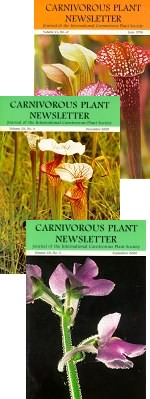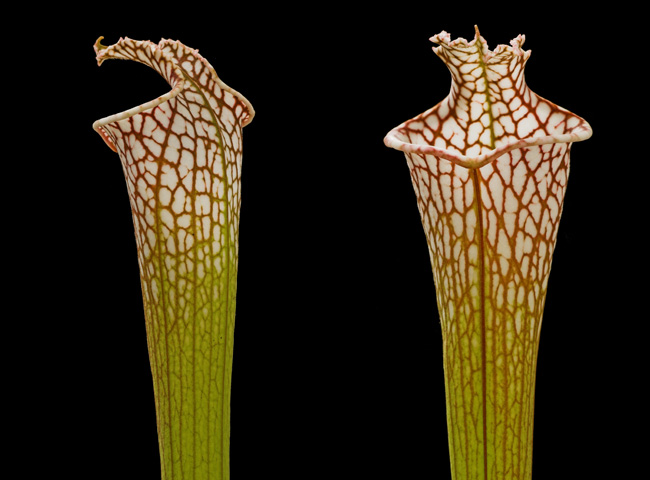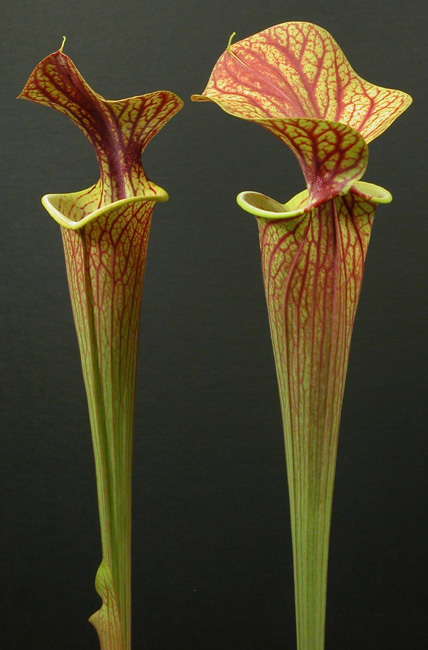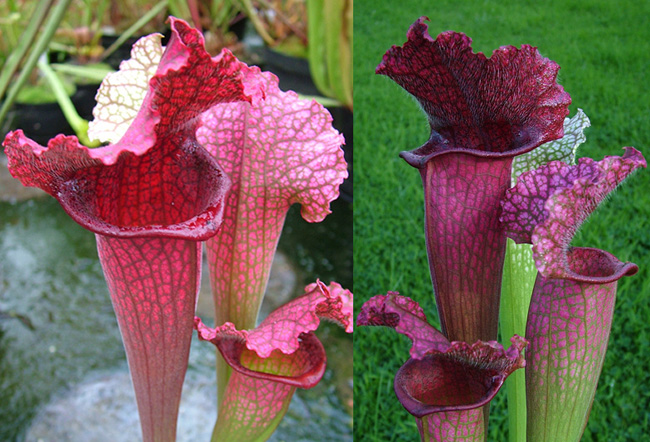
|
| Cultivar Registrations in CPN |
|
Carnivorous Plant Newsletter New Cultivars Sarracenia ‘Bris’ Submitted: 18 March 2008 The particular attributes of this extraordinary Sarracenia leucophylla plant were first noticed in 2004, when I (PD) was working with the plants in the collection at California Carnivores. As a juvenile, the plant had shown good color and coloration, but otherwise did not seem particularly remarkable. However, as it matured, it showed a bizarre mutation in the nature of the lid! Unfortunately, since the inventory at California Carnivores is huge, I (PD) could not trace this plant’s origin, but I suspect it probably originated from ICPS seed bank material. Unlike the lids on normal plants, which when viewed from overhead completely cover the pitcher opening, the lid on this new cultivar is reduced significantly in size (see Figure 1). The lateral development of the lid is highly reduced, so that the lid is often little more than a narrow strip of tissue. The length of the lid is also somewhat shorter than normal, although it terminates in a spur as is normal for the species. On most pitchers, the lid tends to curve slightly downwards, over the pitcher opening, in a manner that is also somewhat atypical for the species. These characters are somewhat peculiar, but we do not believe they originate from hybridization. They are stable in cultivation, as plants cultivated for several years at both California Carnivores and the University of California, Davis, consistently show the peculiar characteristics. It is unlikely that plants propagated by seed would faithfully reproduce the cultivar characteristics, so we recommend propagation by vegetative means. Despite several years of cultivation, we have not yet observed flowers on this clone. The overall appearance of the plant has caused many viewers to remark that this looks like a species of Heliamphora! Because the erect, columnar pitcher appears to have a trimmed appearance to its terminal structures, one of us (BR) proposed the cultivar name in late 2006. The name was instantly approved with teary-eyed laughter by both authors. —PETER D’AMATO • Sebastopol, CA • USA
Figure 1: Sarracenia leucophylla ‘Bris.’ Photograph by Barry Rice. Submitted: 18 July 2007 This new cultivar has stout, greenish yellow pitchers, rising from a large rhizome to a height of at least 56cm (22 inches). The lower two-thirds of the pitcher is characterised by very fine, vertical venation. Thereafter the pitcher flares outward to a wide mouth some 6cm (2.5 inches) across, with a substantial nectar roll that dips to form a graceful spout. Initially a pale yellowish green, the nectar roll becomes bright yellow at maturity. A narrow, linear ala not exceeding 3mm (1/8 inch) extends from lip to base. Pitcher venation becomes more extensive and coarser with height, reaching a maximum on both upper and lower surfaces of the hood. Here the colouration appears to bleed from the veins into surrounding tissue. Areas between the deeply coloured veins may be shaded with colour or speckled as if spattered with paint (see Back Cover). A substantial throat patch liberally supplied with nectar glands spans the full width of the column, the central portion extending vertically down into the pitcher interior and upwards the full length of the hood. This vertical extension of the throat patch may also be repeated on the upper surface of the hood and down through the column. Viewed from above, the near circular hood has a distinct wave and a pronounced spur. Flexure of the column may draw both sides of the hood together until they touch abaxially. Initially red, both the pitcher venation and throat patch darken to purple as the pitchers mature. In autumn, recurvate phyllodia up to 15cm (6 inches) tall are grown which persist through the following winter and spring. Curvature of phyllodia is of a much lesser extent than is typically seen in Sarracenia oreophila. Large, butter-yellow flowers appear to share the characteristics of both Sarracenia flava and Sarracenia oreophila equally. There is a faint, musty perfume reminiscent of S. flava. Sarracenia ‘Hugh Jampton’ was raised from seed in 1989 by UK grower Stephen Locke. The seed was sourced from the Carnivorous Plant Society seedbank and labelled as being Sarracenia flava var. rugelii. As the plant grew, Stephen soon realised that it was in fact a hybrid. The true parentage is uncertain, but it seems likely that the plant is a back-crossed hybrid of Sarracenia flava and Sarracenia oreophila. The cultivar name Sarracenia ‘Hugh Jampton’ is a reference to the short-lived character voiced by Peter Sellers and created by Spike Milligan for the BBC radio series “The Goon Show”, first broadcast during the 1950s. The name was coined in June, 2006. In order to maintain the unique characteristics of the plant, reproduction must be achieved by vegetative methods only. —AIDAN M. SELWYN • Hampshire • United Kingdom
Back cover: Sarracenia ‘Hugh Jampton’. Photograph by Aidan Selwyn. Submitted: 25 October 2007 The description of this Sarracenia × mitchelliana back cross was published in 1998, but the previously published photographs have been somewhat small. As such, for your reference, additional photographs of this plant are being published here as standard illustrations (see Figure 2). —MATTHEW SOPER • Southampton • UK
Figure 2: Sarracenia ‘Juthatip Soper.’ In the description of a new cultivar of Dionaea (Carniv.Pl.Newslett. 37: 26, 2008), the epithet was spelt “Microdents” (as originally submitted in the registration form). The author and registrant has informed us he would prefer the epithet to be ‘Microdent’ (without terminal “s”). The correct name is, therefore, Dionaea ‘Microdent’. |
This page is maintained by Robert Ziemer, |




